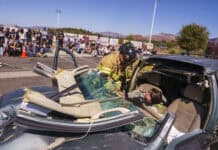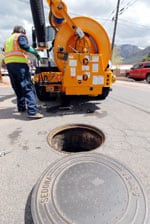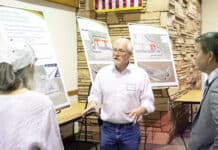Endless dirty double-entendres can fill an article about what lies beneath Sedona?s city streets.
Larson Newspapers
________________
Endless dirty double-entendres can fill an article about what lies beneath Sedona?s city streets.
Inside the 810,000 feet of sewer line extend miles of sewage, muck, or what deems to be the more appropriate term, ?wastewater.?
In order to ?clean the lines,? the city of Sedona recently acquired a new vehicle designated and designed to do the job.
If anyone has seen the mammoth-looking contraption slurping from manholes around town, more than likely that?s the one.
Tuesday morning, March 27, Kim Plapp, employee with the city of Sedona Wastewater Division, watches the 2007 International Vac-Con Unit parked in front of a manhole cover on Mesquite Avenue. The sound of an engine building 3,000-pound force per square inch of suction whirs loudly.
?It sucks the muck, [expletive], wastewater, if you want to be politically correct,? Plapp says loudly, grinning.
According to city of Sedona Director of Wastewater Pat Livingston, the vehicle weighs in at 3,400 pounds almost two tons of sewage-sucking power.
The belly of the vehicle, carried on its back, can hold 800 gallons of water and 5 cubic yards of ingested waste material in its debris tank, she says.
That makes it the biggest thing in Sedona full of ? ?wastewater.?
Oliver Daniren, the truck?s operator, stands before a control panel mounted on the vehicle?s grill. With a few twists and turns of certain knobs and levers, he extracts a massive stainless steel cylinder from the manhole.
Plapp disconnects the cylinder from a long black hose and carries it to the side of the truck where he re-attaches it to the side of the vehicle for storage.
Daniren shifts more knobs and guides the slinky-type hose away from the front of the cab to stow.
When everything is put away, Daniren climbs into the cab of the vehicle and continues to monitor the computerized cockpit. Slowly, the loud whir of the engine decreases to a low hum and the vehicle runs on idle.
Plapp returns to the front of the truck and pushes the iron manhole cover back into its original place, sealing the hole.
According to Plapp, since the creation of the Clean Water Act of 1972, the Arizona Department of Environmental Quality dictates specific environmental standards for city and state.
He says when ADEQ mandated a sewer system, the city complied.
And more recently, the city complied to the mandate for having such a vehicle, he adds.
According to Plapp, the city of Sedona received a great deal on the vehicle. It was once a demonstration vehicle.
He estimates the cost at $280,000 but adds the necessary truck has ?all the bells and whistles.?
In addition to the tubular slurping sensation, Plapp says the truck has a camera, monitor and DVD recorder.
The purpose for the high-tech gadgetry is to give the operator a visual on what the International Vac-Con is ingesting.
The camera can spot if there are line breaks, root intrusions or anything they can foresee as problems for the city of Sedona Public Works Department.
All in all, the deal on the vehicle will save Sedona money by catching necessary repairs before they get out of control, Livingston says.
Perhaps the vehicle doesn?t all suck.
Before Plapp and Daniren mount up and exit the area, Plapp stresses the most important part of his job safety.
They request the same from anyone who sees the effluent elephant in the streets.
?Please drive carefully around us,? Plapp says. ?Watch for us working and be safe.?






















